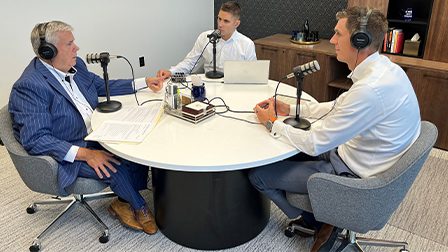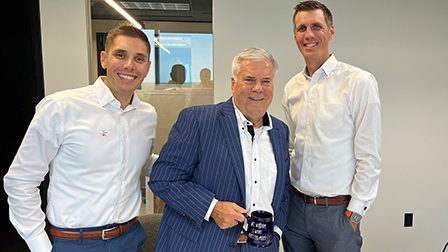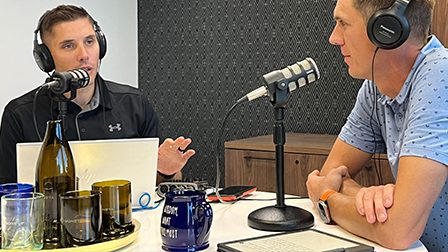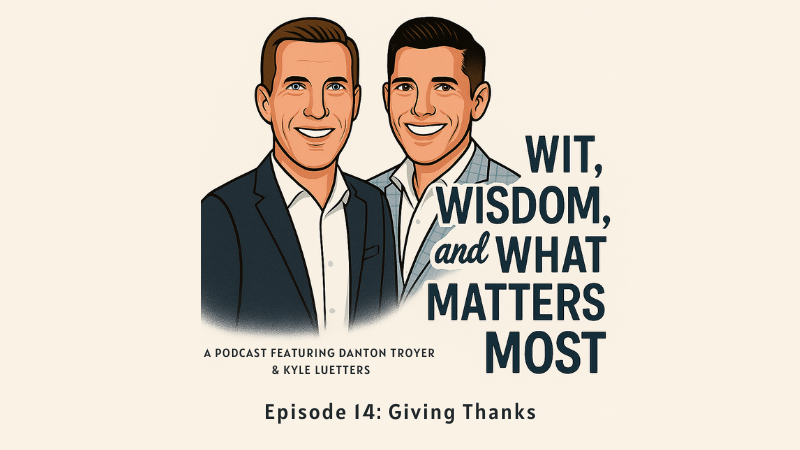Episode Transcript
Episode 14
Giving Thanks
Kyle:
Investment advisory services offered by Moneta Group Investment Advisors, LLC, an investment adviser registered with the Securities and Exchange Commission. Registration does not imply a certain level of skill or training. The information discussed in this podcast is for informational and educational purposes only. You should consult with an appropriately credentialed professional before making any financial, investment, tax, or legal decision. Past performance is not indicative of future returns. All investments are subject to risk of loss.
And welcome to another edition of Wit to Wisdom and What Matters Most. It is a podcast by Moneta’s Gast Freeman Troyer Racen Team. My name is Kyle Luetters, an advisor on the team, joined by Danton Troyer, one of the partners.
Danton, we are literally falling into the back half of this year and really the back two months. It is holiday season, and we wanted to take this edition of the podcast to talk about things that we’re thankful for. Thankful for you, thankful for this podcast, but in addition to that, it also really causes us to think about maybe giving, especially this time of year, you’ll start to see maybe some more requests for giving.
And we wanted to touch on a couple of things as we get to this part of the year about maybe some ways that folks could do some gifting and giving, so we’ll just kind of dive on into that. But as clients continue to grow, charitable giving really seems like it’s one of the most fun and most rewarding things that clients get to do with their money.
Danton:
Yeah, and I think we’re seeing more people put more thought into it than we ever have in the past. You know, churches are always a big recipient of donations, and that’s certainly not the easy button, but I mean, people are affiliated with the church, they kind of know where to go. But then beyond that, they want to have an impact, and it’s not just, you know, donate to United Way; they do great things, but they want to have their own personal impact, and how are they evaluating that? I think it’s changed more so, especially over the last several years, I’ve seen more and more people want to be more involved.
Kyle:
They want to be more involved, and then giving really speaks to causes or even stories that are deeply personal. You know, if you’re a cancer survivor, there may be an organization that targets the type of cancer that you survived, or there may be an organization that really did a lot of good for your children. There’s one couple that I’m aware of that they love Shriners Children’s Hospital because of what Shriners has done for their child, and they tell all of their friends, this is what this organization did for us.
But you know, there’s obviously the emotional side of giving, but then there’s also, too, a mechanical tax-efficiency side, a financial side to giving, if you will. And we wanted to go over a few of those ideas and those topics today, so really, you know, the place for anyone to start with charitable giving is as a cause that speaks to them. You know, first and foremost, there’s got to be a desire because you are parting with these dollars, and the intention, your hope, is these dollars go to further that cause’s mission and their goals.
Beyond that, then we start to get into the weeds and start to get more to the technical side of how all this works. And so one of the things I wanted to bring up first and foremost is donor-advised funds. So up until maybe a handful of years ago, there was this thought that if we were going to do maybe some large gifting or some ongoing gifting that maybe like a family foundation or something like that would be the thing that we have to have.
But really, donor-advised funds have kind of come onto the scene here lately, and they’ve really opened up a lot of opportunity for a lot of folks. Before we get any deeper in the weeds, do you want to kind of go over what the concept of a donor-advised fund is, kind of what it is and how it works?
Danton:
Yeah, I think just to keep it at a high level, it allows folks, I think historically everyone thought you needed to be millions upon millions of dollars to start, quote-unquote, your trust to potentially help these charities. But now they simplified that process and administration, especially the administration, so you’re able to contribute dollars into this account, and you still get to direct those dollars to the charity that means the most to you, or charities as well, but it doesn’t have to be given right then. So you’re allowed to take those dollars, invest them, and let that grow and basically create a fund to support the charities that mean the most to you and have a greater impact for a longer period of time, potentially.
Kyle:
These are fantastic vehicles. There’s a number of conversations we’re having with clients right now, clients really that are at all stages of their giving, they’re either just starting out, or they’ve been gifting for a long time through other methods, and now they’ve found this vehicle, that to your point, does allow them to contribute dollars or appreciated securities into the donor-advised fund, have those funds be invested and carry over year after year until you’re ready to make the gift. And then by the way, as long as it’s a 501c3 organization, you direct the funds back out of the donor-advised fund to the charities to make the impact.
Danton:
Yeah, we’ve seen a lot. This has become more popular obviously just with the increase in the standard deductions, so you’re not getting as much benefit just from donating the $1,000 gift anymore, but if you’re able to lump these all together, you get a little bit more benefit at least in your tax return. So it’s just we’re never really advocating to obviously donate money to increase your net worth, but if you’re going to donate money, let’s do it in the most efficient way possible.
And then how you use specifically this type of tool is different for everybody, and that’s kind of why we like it, is it is fairly flexible in how it is used. So it’s become probably one of the easiest ways to manage your donations in a tax-efficient way.
Kyle:
100%, and there’s a story that rattles around in the back of my mind where prior to the last handful of years, we had a client that sold his business and had a very large capital gain in that year. He went ahead and contributed a portion of those proceeds into a donor advised fund to help offset his tax liability that year. I won’t give the exact number that he contributed, yet I will say it was a healthy six-figure sum, and this was in 2019.
And he went ahead and he invested those funds inside the donor advised fund, and 2020, 2021 are very robust years in the equities markets, and he remained aggressive with those funds. He was able to give away the amount that he had put in, but he still had that original principal left over. So if you think about that, the leveraging power of growth with those investments, and he was able to basically double the amount that he gave, and he got his tax write-off and all these other things, but it brought him and his wife so much joy, so much joy, and what he shared with us was it is so fulfilling to be able to say yes.
When they would meet someone out at a function or they would see something either in the news or this or that, think of any time a natural disaster strikes and the Red Cross or someone’s organizing relief efforts, to be able to say yes in those times of needs because you already, by the way, with the donor advised fund, have a set-aside bucket. You don’t really necessarily have to think about, oh, well, do I give this out of checking or my investments? No, there is a dedicated bucket that is set aside for these types of things. It makes giving, it almost gives you permission to give.
Danton:
Yeah, in that case too, if you’re able to put in a large enough dollar amount where the growth on that alone is going to be a substantial donation, it’s kind of paying for itself and creating that income stream, if you will, within the donor advised fund to fund these charities. So, especially in that type of situation, it makes it pretty easy to continue to give those dollars and feel good about it and know also it’s not really even pulling from your assets that you’re using for just day-to-day life.
Kyle:
Yeah, so donor advised funds, I think that’s a very good starting place and that’s accessible to just nearly anybody. Now let’s talk about something that is pretty effective as well too, the scope, the population that can utilize it is a bit smaller, and that is the Qualified Charitable Distribution or QCD for short. This really kicks in when you get to age 70 and a half. That is the minimum age on it. And it basically allows you to gift directly from your IRA to a charity and not have that income come to your tax return as taxable income.
Danton:
Yeah, I remember when I think I started my career, I used to always tell people, once it’s in that IRA, there’s no way to get it out without paying taxes. So, I kind of got to eat my words now because there is a way to get it out of your IRA and not pay taxes. We always say eventually you got to pay tax on those, but I guess it’s not entirely true.
But the caveat is you don’t get to use those dollars necessarily, they do need to be directed. But if you’re already going to be directing dollars to that charity, again, let’s do it more officially with pre-tax dollars that you would have had to pay taxes on.
Kyle:
And there is a cap on this one as well to the amount of money you can direct out of it. It’s $108,000 per taxpayer in 2025. So if you’re a married couple, that’s $216,000. But we do anticipate now with some recent legislation passed that that will inflate over time. It used to just be for the longest time that I was doing this, it was a flat $100,000.
Danton:
Yeah, obviously, inflation, especially here recently, has been a little bit higher than we’re used to, and there’s no reason for that not to increase as well, hopefully. And we’re seeing that as well with people trying to donate to charities. I think that’s one of the best things we can do as populations can continue to support these charities and providing these tax benefits, I think is a good thing.
Kyle:
And speaking of tax benefits, the QCD works whether you take the standard deduction or an itemized deduction. And I think it’s a very powerful tool if you look at the way things land on the tax return. It’s certainly an above-the-line deal because it is dollar-for-dollar reducing taxable income. You don’t have to go through the deductions or this or that, so it is an extremely powerful tool. And what we will actually advise a number of clients to do if they are that charitably inclined once they get to that age, they may have been contributing to a donor-advised fund for years, but once they hit 70 and a half, this gateway’s kind of opened.
Danton:
This is even easier than the donor-advised fund in many ways because you just go straight there and you get the tax benefit and it doesn’t even hit your tax return. So yeah, it’s certainly a smaller population because you have to be at that RMD age. But for the ease of use, it’s a great tool to kind of keep in mind, especially as you get towards this time of year and you’re thinking about, oh, I’ve got to take this money out by December 31st, it’s going to hit my tax return, what is it going to do?
This is a way you can maybe mitigate some of that risk. You don’t have to do the full amount. If your requirement of distribution is $100,000, you can do as much under that as you would like.
Kyle:
Exactly. And I would say one thing that is extremely important with a QCD, when custodians, so Schwab, Fidelity, any number of these folks, Vanguard, when they send out tax documents, 1099Rs for a distribution from a retirement account, they don’t list out where everything went. They just show you, hey, what left?
It is on the taxpayer to make sure that they obtain a receipt from the charity once they receive those dollars. That way, your tax preparer can match up the distribution with a charitable contribution. Otherwise, it’s considered taxable, and we have seen instances in going through tax returns where the client will say, look, I made a QCD.Why am I paying this much more in tax? And when you dig into the weeds, as we do, you’ll find out that the receipt was not passed along to the preparer, they weren’t able to match that up, and we amend the return if we need to.
Danton:
I think the other pitfall we’ve seen, especially when we’re talking about year-end giving here, but waiting to year-end may not always be the greatest strategy, especially waiting until the very end. We’ve seen charities just sit on checks, not cash them. That’s been a huge issue, where if you’re sending out checks on December 31st, they’re not going to get there.
And even if you’re sending them out now in November, end of the year, some of these charities, their staff is not huge, and they do need the money, and they want the money, but they got to work to process those. So it can be slower, especially on those smaller charities, and you run the risk of them not getting those dollars before year-end as well.
Kyle:
Exactly. And the checks must be cashed in the year that you are trying to make all of this happen. We were speaking with a client the other day, and really, as Danton alluded to, this time of year, everybody’s thinking about gifting as well as giving, you can kind of use those words interchangeably.
We actually asked the gentleman to go to some of the charities that he supports and say, hey, I was going to gift anyway. Is there a certain time of the year that there might be a low linear giving? If everybody else is doing it right now, could you really benefit from these funds maybe in May, when things are a little leaner? Maybe I’ll just orient my giving around then. That helps you kind of spread it out across the calendar year and make sure that everything happens the way that you want it to. So Danton, those are, I would say, the acronyms, DAF, QCD.
Now let’s talk about, if you don’t really necessarily want to go through a mechanism or go through something, one idea that I think makes more sense than giving cash, especially if you have a large non-retirement account, is gifting appreciated assets directly to an organization. Do you want to kind of walk through how that process goes?
Danton:
Yeah, we’ve seen a nice run up in the market over the last couple of years for sure. Especially working with a lot of executives, they may have employer stock, they may have other positions in their portfolio that have substantial gains. This is a simple way to essentially reset your basis, or how much you would pay in gains, on the stock down the road by simply donating shares of employer stock, as an example.
S&P 500 is setting new highs almost every day, it seems like. You could gift those shares to the charity, and the charity’s not going to have to pay taxes on them, but you will if you were to sell them. So, it’s an easy way to get around those taxes.
If you still want to keep those dollars, if you were going to give the charity cash, just go buy that, in this example, S&P 500 fund with the cash, give them the stock, and it resets for you.
Kyle:
That is an extremely effective tax strategy that we utilize quite often. And again, too, we’ve seen this, or witnessed this personally with, I’ll use the example of charitables with capital campaigns. They’re going to build a building, they’re going to acquire a piece of land, they’re going to retire some debt.
Folks will take shares of an individually held stock, or they’ll take shares of something like an S&P 500 index fund, and gift them directly. They might have 130, 140, 150% gain, I’m just kind of ballparking some numbers. But by gifting that, the charity gets the fair market value of the gift, and in a sense, the taxable gain for the client is removed.
Danton:
Correct.
Kyle:
And so it becomes a much more powerful gift from a tax standpoint than just cash, and then to Danton’s point, using the cash that you were going to give to go ahead and buy the same position, but now your basis – your floor- is much, much higher. So if you’re doing one of those transactions, it’s very important to understand the backoffice side of things, and that’s where working with somebody, a financial planning firm or something like that, really comes into play because they have to be sent electronically, they have to be done so in the right way. There are a lot of big eight- and nine-digit numbers that are involved in these things, and you want to make sure it’s done right. So that is one of the things that’s very key to remember there.
One of the final bullet points that I wanted to really hit here from Danton’s earlier comment about the standard deduction versus the itemized deduction is this concept of bunching donations, and do you kind of want to maybe go through that concept just a little bit, Danton?
Danton:
Yeah, we talk about a little bit with the donor-advised funds kind of easy example where if you’re going to, every year you give $10,000 to a charity, but you’re just under that standard deduction, you’re not getting a tax break, well, why don’t we take the next five years of donations, in this case, throw them in the donor-advised fund, it’s already counted as your complete gift, but you’re actually going to get some benefit to making that gift on your tax return as well.
So it’s just a simple-ish way to be able to pre-fund those donations, but you’re actually going to get a tax benefit versus just giving it to the charity directly and staying under that deduction for the next five years.
Kyle:
I love that as well, too. It’s a strategy that’s really become more in vogue since the standard deduction did double and then some, over the past several pieces of legislation. One thing to keep an eye out for in 2026, as a part of the Big Beautiful Bill legislation, there now will be a $2,000 charitable, basically a write-off, if you will, above the line on the 1040.
So that will change up some gifting strategies a little bit, again, this is where working with a planning team really can come into play in sequencing some of these things. So, do we contribute cash for the first $2,000,. and then do we do a QCD for a certain amount, and then do we do some out of a donor? There’s a lot of sequencing that can go into this, but I don’t want folks to hear that this has to be overly complicated.
It really should just be as simple as if you want to give, give, and you have the means to do it and it matters to you.
Danton:
Yeah, I think that’s a good summary of all of this. There’s all these different strategies you can use, but at the end of the day, making the donation that’s meaningful to you is going to be the most important part of it. Obviously, we’re here to help from the tax strategies and figure all that behind the scenes, but the reality is we want you to be making donations that are meaningful to you.
Kyle:
Yeah, 100%. If you do get down the line and there’s a lot of gifting going on, someone that I do want to have on a future episode of the podcast is here at Moneta, her name is Deb Durbin, and she helps a lot of families codify their giving strategy and that’s a concept that we’re going to expand upon a little bit more, but really what Danton and I wanted to do today is, like I said, it’s a charitable time of year, it’s a giving time of the year.
We wanted to just take some time here before we sit down at the holidays and really kind of go through some of these various strategies of how you can bless others.
Danton:
Yeah, I agree.
Kyle:
All right. Well, that’ll do it for this edition of Wit, Wisdom, and What Matters Most. It is produced by Moneta’s Gast Freeman Troyer Racen Team, headquartered in St. Louis, Missouri. Until next time, enjoy what matters most.
© 2025 Advisory services offered by Moneta Group Investment Advisors, LLC, 100 South Brentwood Blvd., St. Louis, MO 63105 (“MGIA”), an investment adviser registered with the Securities and Exchange Commission (“SEC”). MGIA is a wholly owned subsidiary of Moneta Group, LLC. Registration as an investment adviser does not imply a certain level of skill or training. This is an advertisement. The information contained herein is for informational purposes only, is not intended to be comprehensive or exclusive, and is based on materials deemed reliable, but the accuracy of which has not been verified. Examples contained herein are for illustrative purposes only based on generic assumptions. Given the dynamic nature of the subject matter and the environment in which this communication was written, the information contained herein is subject to change. This is not an offer to sell or buy securities, nor does it represent any specific recommendation. You should consult with an appropriately credentialed professional before making any financial, investment, tax, or legal decision. Past performance is not indicative of future returns. You cannot invest directly in an index. All investments are subject to a risk of loss. Diversification and strategic asset allocation do not assure profit or protect against loss in declining markets. These materials do not take into consideration your personal circumstances, financial or otherwise. Trademarks and copyrights of materials linked herein are the property of their respective owners.




© 2025 Advisory services offered by Moneta Group Investment Advisors, LLC, 100 South Brentwood Blvd., St. Louis, MO 63105 (“MGIA”), an investment adviser registered with the Securities and Exchange Commission (“SEC”). MGIA is a wholly owned subsidiary of Moneta Group, LLC. Registration as an investment adviser does not imply a certain level of skill or training. This is an advertisement. The information contained herein is for informational purposes only, is not intended to be comprehensive or exclusive, and is based on materials deemed reliable, but the accuracy of which has not been verified. Examples contained herein are for illustrative purposes only based on generic assumptions. Given the dynamic nature of the subject matter and the environment in which this communication was written, the information contained herein is subject to change. This is not an offer to sell or buy securities, nor does it represent any specific recommendation. You should consult with an appropriately credentialed professional before making any financial, investment, tax, or legal decision. Past performance is not indicative of future returns. You cannot invest directly in an index. All investments are subject to a risk of loss. Diversification and strategic asset allocation do not assure profit or protect against loss in declining markets. These materials do not take into consideration your personal circumstances, financial or otherwise. Trademarks and copyrights of materials linked herein are the property of their respective owners.



